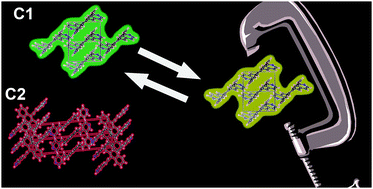Understanding the solid state luminescence and piezochromic properties in polymorphs of an anthracene derivative†
Abstract
Luminescent molecular crystals have gained significant research interest for optoelectronic applications. However, fully understanding their structural and electronic relationships in the condensed phase and under external stimuli remains a significant challenge. Here, piezochromism in the molecular crystal 9,10-bis((E)-2-(pyridin-4-yl)vinyl)anthracene (BP4VA) is studied using a combination of density functional theory (DFT) and time-dependent TD-DFT. We investigate the effects that molecular packing and geometry have on the electronic and phonon structure and the excited state properties in this archetypal system. We find that the luminescence properties are red-shifted with the transition from a herringbone to a sheet packing arrangement. An almost continuous red-shift in the band gap is found with the application of an external pressure through the enhancement of π–π and CH–π interactions, and is a mechanism in fine tuning an emissive response. The analysis of the phonon structure of the molecular crystal suggests restriction of motion in the herringbone packing arrangement, with motion restricted at higher pressure. This is supported by the Huang–Rhys factors which show a decrease in the reorganisation energy with the application of pressure. Ultimately, a balance between the decrease in reorganisation energies and the increase in exciton coupling will determine whether nonradiative decay is enhanced or decreased with the increase in pressure in these systems.

- This article is part of the themed collection: 2022 PCCP HOT Articles


 Please wait while we load your content...
Please wait while we load your content...